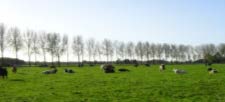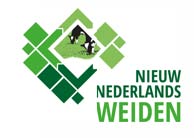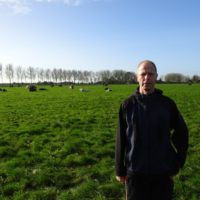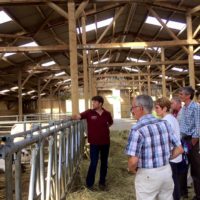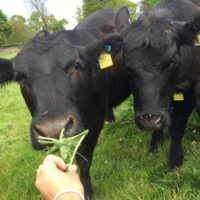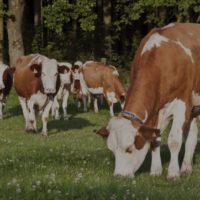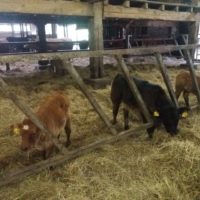Compartmented continuous grazing (“Nieuw Nederlands Weiden”)
Farm: “Hielke and Hanny de Rooij”
Location: Wadenoijen, The Netherlands
Case study
 Compartmented continuous grazing (“Nieuw Nederlands Weiden”) (.pdf)
Compartmented continuous grazing (“Nieuw Nederlands Weiden”) (.pdf)
Description
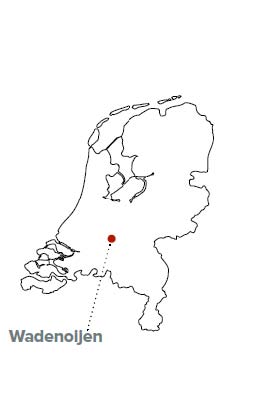 Background
Background
Hielke and Hanny de Rooij run a dairy farm in the center of the Netherlands. They have around 100 ha on their farm. The majority (67.5 ha) is permanent grassland. This is complemented with 10 ha grass clover, 5 ha mixture of tall fescue and Italian ryegrass, 14 ha/forage maize and 3.5 ha wood/trees. The cows (170) produce on average 9,200 kg milk per year with 4.47% fat and 3.72% protein. The farmers are aiming at the inclusion of grazing in their dairy farm as much as possible. However, the grazing platform of their farm is relatively limited due to a railway and several roads and is only 22 ha. Therefore, they graze 7 to 8 cows per ha grazing platform.
Detailed description
In order to combine efficient grass utilisation and efficient cow production, Hielke and Hanny de Rooij work with a new grazing system, that was recently developed in the Netherlands: compartmented continuous grazing (in Dutch: “Nieuw Nederlands Weiden”). Compartmented continuous grazing is an adapted set-stocking system for stocking rates up to 10 animals per ha in which the cows rotate on a daily basis between six compartments on one platform. Each day, cows are moved to a new compartment and in a period of 5-6 days, they rotate on five or six compartments. The (variable) sixth compartment is cut for silage to increase sward utilisation. So, cows come back in the same compartment after 5-6 days. The average grass height in the compartments is kept constant (8-12 cm) so that daily regrowth is available for intake. The gap between daily regrowth and animal demand is filled with supplementation.
The grazing system was developed a few years ago in the Netherlands as a system that combines high grazing efficiency with ease of labour in dairy systems that have a high stocking rate and a high milk production per cow.
Results
The results of compartmented continuous grazing are very positive on the farm. Hielke and Hanny de Rooij conclude that they can feed a lot of fresh grass and utilise the protein grown on their farm in an efficient way. They achieve a high milk production with the grazing system. Furthermore, the system was easy to implement, did not require a lot of labour / management skills and gave good results with respect to milk production and grass utilisation. The area on the farm that is available for grazing will be optimally used with this grazing system.
Adoption criteria
Compartmented continuous grazing combines the best of two worlds: efficient grass utilisation and efficient cow production. It balances grass intake, grass utilisation and labour needed. It is:
- Efficient: utilise fresh grass for optimal milk production
- Structured: every day both the farmer and the cows know where they stand
- Robust: easy to adapt to weather fluctuations and seasons
Farmers that would like to implement the system need to follow 3 steps.
Step 1 (only once or once a year):
- Divide the grazing platform in a number of equal-sized paddocks (if necessary combine small parcels into one parcel or divide large parcels)
- Number of parcels depends on herd size, size of grazing platform and supplementation level (decision support tools are available)
- Invest in infrastructure to facilitate grazing: water, roadways, fencing, etc.
- Mow the paddocks that were set for mowing
- Choose your new grazing platform
- Fence the new grazing platform
- Put cattle in pasture at maximum 12 cm grass height
Step 3 (daily):
- Every day a new paddock
- Put cattle out at minimum 8 cm grass height
- Adjust supplemental feeding when needed, depending on grass height of the paddock that cows have just left
- Grass too long: less supplementation
- Grass too short: more supplementation
Tips for the best result
- Start early in spring with grazing
- Minimise supplementation to increase fresh grass intake
- Animal manure only for first cut and for paddocks that will be mown
- Organise good paddock access
Future prospects
Compartmented continuous grazing is the solution for dairy farmers that would like to increase the amount of fresh grass converted into milk while spending not too much time on grazing management. The system will be used in many Dutch dairy farms in the near future.
Additional information
| Farming system | conventional farming |
|---|---|
| Domains of innovation | landscape, legume management – Perennial legumes, marketing |
| Main types of animal | dairy cattle |
| Country | The Netherlands |
| Product type | Case study |
| Language | English |

